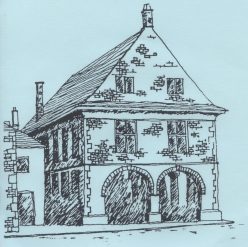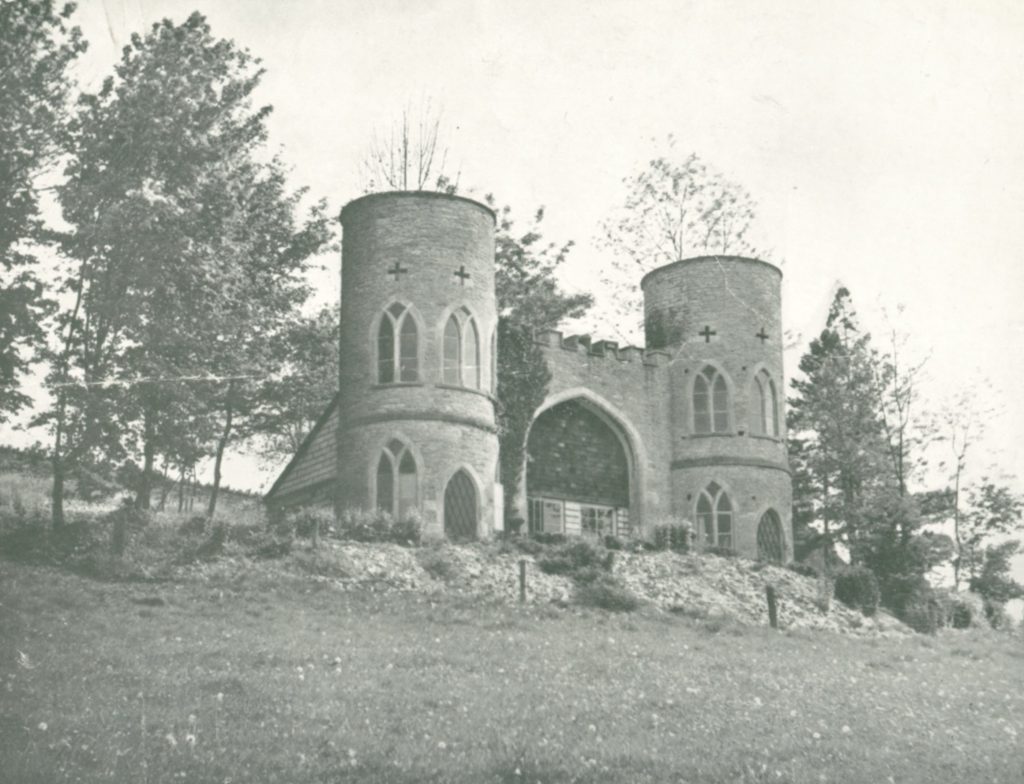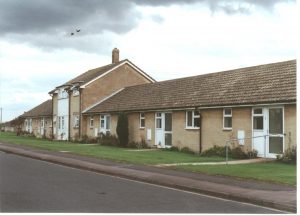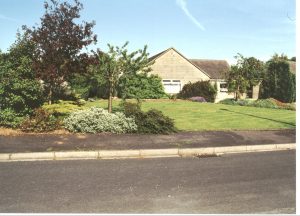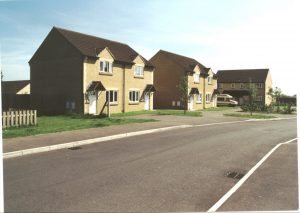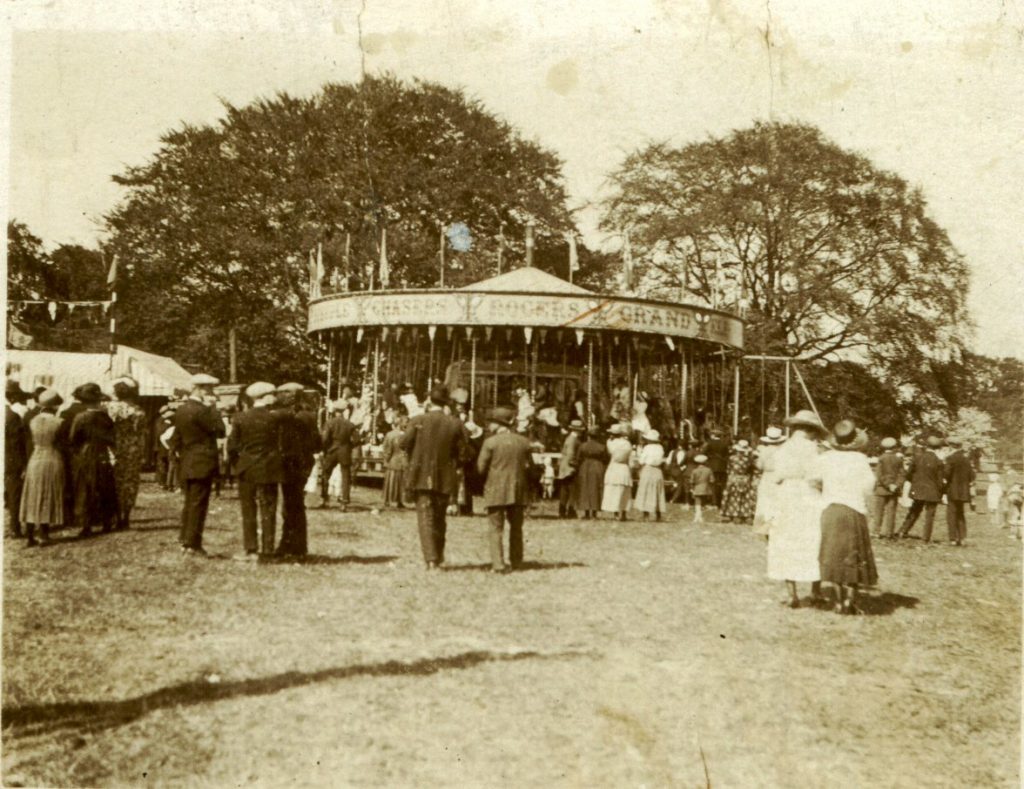THE GATEWAY, AMBERLEY
This landmark is perfectly described in a book titled “Follies”, by Gwen Headily and Wim Meulenkamp: “The Amberley eye-catcher, a house called the Gateways in St. Chloe, was built by the wonderfully named Sir George Onisiphorous Paul, who died in 1820, as an eye-catcher to Rodborough Manor, which burned down in 1906. Two round towers are joined by a battlemented arch, now filled in. The architect was probably Anthony Teck, although the whole structure looks Sanderson Miller-ish. The best view of it comes from the A46 below, but it is difficult to see it on a sunny morning as it hides against the hillside. The eye-catcher also goes under the name Rodborough Lodge, and a c1906 postcard showing it in an unspoiled state, is subtitled ‘The Hermitage Manor House’”
Many landscape gardens of the period were enhanced by follies, the pyramid at Gatcombe Park being another example. Maps of the early C19th show a series of circular walks around the fringes of the Paul estate, through woodland, and along the small valley, which today marks the boundary between the civil parishes of Minchinhampton and Rodborough, where ponds were created along the stream. The walled kitchen garden existed until fairly recently alongside the main road at Woodchester, and the entrance lodge and carriageway can still be seen. Some local stories centre on the fact that the grounds were enhanced for a royal visit in the C18th. Certainly, in August 1788, King George III, Queen Charlotte and the three eldest princesses visited Stroud on the way back from a visit to Cheltenham for the king’s health. They visited Woodchester Mill, described by chroniclers of the time as “the clothing manufactory of Mr. Obadiah Paul”, and breakfasted at Hill House (another name for Rodborough Manor), “the seat of Sir George Onisiphorous Paul”. Perhaps the tales are true, the dates appear to correspond, and it would not have been the first time that a wealthy man had spent money improving his home to entertain royalty.
********************
THE GLEBE ESTATE
The word glebe comes from the Latin “gleba” and means church land. In the C17th all of the land to the east of Butt Street, from Friday Street to Blue Boys Farm is listed as property belonging to Holy Trinity Church. Although the Rectory (now Stuart House) was built on this land in 1721, then cottages fronting on to Butt Street, the Coigne, the Priests House and the current Rectory, most of it remained farmland. The turnpike roads and railways bypassed Minchinhampton so there was little growth in population and the town stagnated. There was no pressure for building, and in 1830 just over seven acres are listed as Glebe Pasture, the rest having been purchased from Holy Trinity Church by the Chambers family, who owned Blue Boys Inn.
Following World War I there was a desire to provide cheap housing for those who needed it. “Homes for Heroes” were provided in the larger towns and in Minchinhampton Stroud R.D.C. provided the first “council houses”; those at the top of Tetbury Street, and parts of Box Crescent and the Tynings were built in the thirties. In 1937 the Chambers family sold Blue Boys with the three fields of pasture to the southeast to Arthur Summers for the sum of £1,200. Two years later the field on the corner of Butt Street and Old Common was conveyed to Evan Hopkins of Tetbury, and was developed for bungalows and houses but the old boundary of the field was preserved in the line of the new road – Summersfield Road. After World War II Arthur Summers disposed of his remaining two fields and these were purchased by Stroud R.D.C. to be developed over a period of time into the Glebe Estate.
The post-war baby boom provided the impetus, and after initial problems with drainage (which caused more then one hopeful occupier to write in strong terms to the press!) 62 houses were completed in Phase One. They were built by traditional methods, of concrete block that was then rendered, in terraces of four or six. All had individual front and back gardens, featured coal sheds and were laid out around three cul-de-sacs called simply “The Glebe”.
By the mid sixties it became apparent that further housing to rent was needed and the road was continued to the east, which necessitated the re-numbering of half the existing properties. The new properties were of a prefabricated design, composed of pre-cast concrete sections, bolted together on site. To the south of the road semi-detached houses were built; recognition of the problems of old-age and an increasing lifespan led to the provision of bungalows to the north, and also George Pearce House, an elderly persons complex with a warden. Society was changing in other ways, and the R.D.C. recognised that many houses were family occupied and provided a playground on the site. None of the houses in Phase One or Two had garages and these were provided in rows to the rear of some of the properties.
Phase Three was completed in the early seventies when the vacant land was in-filled with bungalows and semi-detached houses, of reconstructed stone, built in the traditional way. The front gardens were now open-plan, although this meant that a cattle grid had to be provided on Summersfield Road to prevent damage by cattle straying from the common. It became obvious that houses would again have to be re-numbered and new street names were required. The Parish Council were consulted and chose historical names – Trinity Drive from the parish church, Syon Road from the Abbey which owned the manor in mediaeval times, and Eastfield Road from one of the open fields which had lain adjacent to the Glebe – now called Glebe Road.
The small portion of land that remained was sold to a private developer, who built the 11 luxury bungalows of Summersfield Close in the late seventies. Meanwhile, political will wrought changes to the rest of the estate. The Tory “Right to Buy” legislation encouraged tenants to buy the properties they occupied and a good proportion of the houses are now privately owned, finding expression in the increasing individuality of the houses and gardens. The provision of accommodation for the elderly is safeguarded, as these remain in S.D.C. ownership. By the nineties, however, it became apparent that there was a shortage of “low cost” housing anywhere in Minchinhampton, and the play area was relocated, further land purchased and Phase Four, semi-detached houses built by a Housing Association, were constructed. These carry the name of the Bulwarks – the ancient earthwork to the south of the site.
The Glebe Estate is a true landmark in the town of Minchinhampton, and provides a good example of how a housing area evolves through the years. As the earliest houses approach their half-century, it is apparent that this evolution will continue throughout the C21st.
********************
THE GREAT PARK
After the Norman Conquest, William I gave the manor of Hampton to the nuns of Caen in Normandy (hence the name Minchin – Hampton from the word “mynchen” or nun). The manor was run as an estate bringing wealth to the absentee landlord – the Abbess – through the sale of wool, grain and other agricultural goods. A steward ran all the day-to-day affairs and one, Simon of Felsted, was enclosing the park in the C12th, to provide wood and meat through hunting. By 1712 an engraving shows a walled pleasure ground almost surrounding “the large mansion near the Church (which) … was occupied by the firmarius or receiver of Abbey rents”. To the north was “a spacious grove of high trees in a park adjoining to it, which is seen at a great distance.” This is now called the Great Park and had been demesne (or private) land belonging to the Lord of the Manor – first the religious houses, then the Sheppard family and lastly the Ricardos.
By the nineteenth century the area by Dr. Brown’s Road (then part of Burleigh Lane) was regularly used for military gatherings and manoeuvres, in Napoleonic times by the Loyal Stroud Volunteers and later the Gloucestershire Rifle Volunteers, thus acquiring the name Camp Field. A copse of trees and a flagstaff marked the centre of the parade area. As the Ricardo family lived at Gatcombe, the park had become somewhat of a public open space, although it was never part of the Common, with all the rights that entailed. The old turnpike road between Stroud and London marked the limit of the Great Park, and along that boundary was a wall and ditch with entrance gateways or arches, still visible in the line of brambles today. Some of the land by Bell Lane was donated to build the first Minchinhampton Schools in 1868, and the Master’s House.
Population was attracted into the area in the early years of the last century, and the Victoria County History suggests that the increase in building around the Great Park was due to the open space and nearby golf course. Certainly, fairways were evident on the maps of the time, and many “Art and Crafts” houses are listed in Buildings of Gloucestershire. On the north side are the gabled Frome Top, Highfield, Greystones “probably by Jewson … a more refined version of Highfield” and Upmead, “in much more spacious grounds, 1925 by Falconer, Baker and Campbell for Miss Hartley, the jam heiress.” Hunters Lodge is probably by Ernest Barnsley, dated c1922. Two other large houses of 1911 – 12 by Thomas Falconer stand on the south side of the park, Bowman’s Green and Windrush. The former is “on a butterfly plan, and there are smaller houses of 1933 on the Butt Street side”.
In 1907 Major Ricardo sold the Great Park to Minchinhampton Golf Club, the wall was removed and thirty acres of grazing land were added to that on the Common “for grazing in return for the Club’s formal right to play golf and maintain the course”. Whenever there were disputes about the fairways being mown in the closed season, graziers were reminded about these thirty acres of private land! As it was not part of Minchinhampton Common, agreements were made to allow the funfair and similar entertainments to be set up – as the fair and the circus are today. Even the hard-standing for cars financed by the Parish Council would have been difficult to undertake were it not for this status. Finally, in 1981 the Golf Club offered the Great Park for sale at £15,000, plus legal fees, to the people of Minchinhampton. A public appeal was launched in conjunction with the National Trust, the money was raised and the land finally passed into public ownership.
********************
THE HISTORY OF HORSLEY PRISON
Roy Close
The prison at Horsley was one of four “Houses of Correction” built in Gloucestershire, after a l883 Act of Parliament, by a commission headed by the champion of prison reform in the county, Sir George Onesiphorous Paul. All four (the others were at Littledean, Northleach and Lawford Gate) were of similar construction to the Gloucester Penitentiary, but on a smaller scale and all were to be run with the intention of fulfilling his ideas to check the early dawning of vice by some form of detention. In 1783 he declared “Bread, water and air, as the means of healthful existence, should be denied to no prisoner, with fresh air as essential to the purposes of life as food.” These ideas were clearly reflected in his insistence that provision of work, controlled diets and health and religious education were to be the main priorities for the prison authorities and staff.
Horsley prison was built on the site of the original priory, which in 1783 was owned by Henry Stephens, the Lord of the Manor. After an approach from Paul he agreed to give this piece of land, adjoining the churchyard, specifically for this purpose. For this very charitable act, the commission decided his generosity should be recorded in the Gloucester Journal and that a commemorative inscription be mounted in the prison. Although contracts were signed in 1786 the early work was delayed by a series of mishaps, varying from an accident to the surveyor when he lost a leg, the bankruptcy of a contractor to shortages of building materials. Eventually the work was completed in 1792, twice the estimated time and possibly twice the quoted cost.
Opened by the Horsley Justices on 20th October 1792, the prison consisted of a keeper’s house with a magistrates’ committee room, a turnkey’s lodge with baths and fumigating rooms, an infirmary, chapel, courtyards, dayrooms and cells. Flues warmed the latter, the heat being checked daily by the prison officers with a thermometer.
On admission, all prisoners were thoroughly washed, given a prison uniform in place of their verminous clothing, divided into four classes and subjected to the appropriate discipline — generally labour proportionate to their age and force, and separated where possible. Women prisoners were responsible for all the cleaning and washing in the prison.
Petty Sessions were held at the prison until 1801 when the agreement lapsed. After several years the rules were revised and specified that they were to be held at certain times to appoint auditors, overseers and the granting of public house licensing and this resulted in the Sessions returning in 1808.
Although most of the prisoners had committed the more common offences such as petty theft, larceny, or were a vagabond or rogue, some were guilty of the more unusual ones. Among those listed in the records are cases of bastardy, wool employment offences, leaving a wife and children chargeable to the Parish, and even an instance of riding on a wagon without holding the reins! Women as well as men could initiate disturbances. Clara Dunning was an agricultural labourer who had moved to Box from Minety. One day, whilst working in the fields the wedding bells were heard, and upon enquiry she was told it was for John Packer’s wedding. She immediately shouldered her rake, marched into the village and disturbed the wedding guests with shouts and splinters of glass from broken windowpanes. Apparently she had been having an affair with John in Minety, and although she herself was now married she was still jealous! Clara was fined and spent some time in the Horsley House of Correction.
From 1840 there was a considerable increase in those sentenced for stealing-food. (This was felt by Paul to be connected with the rising price of food). An example from Box is that of Job Walkley who called for some potatoes from Joseph Evans. He asked for a quarter at 6d, wrapped them in his handkerchief and walked off without paying saying, “you owe me seven pence and this will do”. A quarrel developed, Joseph’s wife joined in and Job Walkley was sentenced to a ten-shilling fine or seven days in the Horsley Gaol. He chose the latter! Defendants involved in the more serious cases of threats to kill, rape and assault were held at Horsley pending trial at Gloucester Assizes.
Most sentences were of one or two months duration, although women found guilty of bastardy could be sentenced for up to twelve months. The largest number of inmates held at any one time was 37, whilst the approximate yearly average was nearly ten times that number. In 1792 Paul was largely responsible for the installation of a broadloom as a means of providing work, the proceeds from the sale of cloth being divided between inmates, the courts and the Governor. Prisoners also did some cloth dyeing, domestic and garden chores, whilst women with suckling children were given light duties. In the 1830s a decision to install a tread-wheel to provide power for the mill led to considerable complaint from the prisoners who had to work it, mainly because of the heavy, physical demand it required. One visiting magistrate ruled they should change places every two rounds instead of the previous four, but then allowed a second wheel to be worked by the women prisoners. However, an increase in illnesses resulting from the work eventually led to visiting surgeons refusing to allow certain prisoners to do the work. During the same period, though, one prisoner, George Cooper, was ordered on the wheel because he had put on a stone in weight, and had become too fat for his own good!
A fairly strict control was exercised over the prisoners’ diets, with the main items being bread, with oatmeal for breakfast, and usually a meat dinner as the main meal, served with vegetables from the garden. Measured quantities of salt were also issued, whilst on Sundays extra meat was provided, with broth from the bones being served the following day. In cases of sickness the surgeon could order mutton broth and gruel, with occasional delicacies such as ginger and tea. Paul was sympathetic to the needs of women with suckling children, ensuring they had an adequate diet by allowing them extra bread and an additional penny a day. An indication of the high standard of their diets is illustrated by a 1822 directive which ordered a lowering, as the standards were higher than those of the long-stay prisoners in Gloucester.
A high standard of cleanliness was also expected. Paul, in 1795, blamed the new keeper for the dirty living conditions, and later refused to accept overcrowding as a cause of dirty accommodation. An immediate order was made that half the prisoners would undertake the cleaning, whilst the remainder carried on with the normal work. This brought about a considerable improvement as it was noted, “that the walls had been newly white¬washed while all surfaces were clean.” Still on this theme, in 1822, a visiting magistrate accused the authorities of neglect, because some prisoners were wearing the same stockings for almost two months, and the same shirt for at least a month.
The emphasis on religion is illustrated by the action of the authorities following Paul’s attendance at a Good Friday service, when he complained that some prisoners were not properly attentive or respectful. They were immediately punished by loss of privileges and special lessons were introduced to improve their behaviour and participation in services. This, and Paul’s insistence that other ministers should deputise for the regular one to ensure services were not reduced, clearly brought about improvements, reflected in a request for extra Bibles and Testaments to encourage the prisoners to read them. Some were actually taught to write in large and small print from these books.
The authorities also had problems with the health and security of the prisoners in various ways. A spare room was used to bleed prisoners who were mentally disturbed, (apparently a regular practice in Victorian times) and one turnkey was removed from his post because of his mental state. Deaths also, unfortunately, occurred, with listed causes varying from “A visitation of God”, Typhus and Dropsy, as well as the more usual ones. Surgeons attended whippings, and on several occasions in the 1840s ordered them to be stopped before the number of nominated lashes had been carried out.
Security was a continual problem throughout the life of Horsley Gaol, for as early as 1794 the turnkey was dismissed for opening the cell doors too early and allowing two prisoners to escape, while in 1821 another was dismissed for being in a drunken stupor on duty, when one prisoner escaped. The locks were regularly picked, with records indicating several instances of escapes by this means, despite the locks being changed. Escapes apparently caused concern in the village, as during this period plans were made to fit a warning bell to rouse the village when this occurred. Unfortunately, after installation it was found to be cracked and could not be heard outside the prison walls! However, despite all its problems, the prison was regarded as a well-run and ordered house, well supervised by staff, magistrates and surgeons, all of whom showed genuine concern for the care of the inmates. In 1809 Paul reported it as the most neatly kept and best managed in this, or any other county.
In the latter half of the nineteenth century the use of the prison declined sharply, in 1867-76 being used only as a remand centre for those appearing at Gloucester, although still requiring a keeper. It was eventually closed, sold and partly demolished in 1878, although apparently some parts were used to form a mansion that became known as “The Priory”. This was until recently used for administration purposes by the Highways Department of the County Council. During my childhood we were able to explore the old dungeon passages, when we could take advantage of the openings made accessible by local knowledge.
